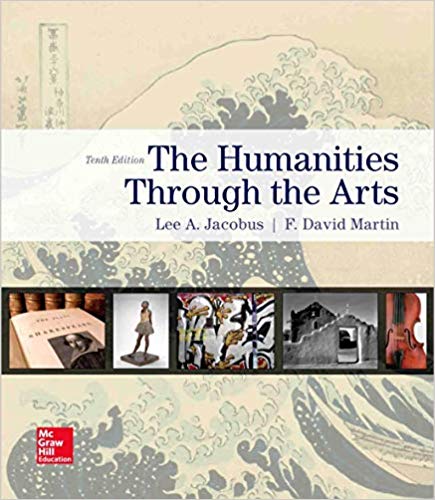Test Bank for Humanities Through The Arts 10Th Edition By Lee Jacobus
Original price was: $75.00.$35.00Current price is: $35.00.
Test Bank for Humanities Through The Arts 10Th Edition By Lee Jacobus contains questions and answers that professors can use to create exams and quizzes. Test banks typically contain multiple-choice, true/false, and essay questions. Test Bank for Humanities Through The Arts 10Th Edition By Lee Jacobus also provides professors with the opportunity to create exam questions that are specifically tailored to their course material.
In addition, Test Bank for Humanities Through The Arts 10Th Edition By Lee Jacobus can be used to create practice quizzes and tests for students. This allows students to get a feel for the material that will be covered on an upcoming exam. Test Bank for Humanities Through The Arts 10Th Edition By Lee Jacobus is an essential resource for any professor teaching a humanities course.
Description
Test Bank for Humanities Through The Arts 10Th Edition By Lee Jacobus
Humanities through the Arts, 10e (Jacobus)
Chapter 3 Being a Critic of the Arts
1) Interpretive criticism centers upon
A) formal elements of a work.
B) the content.
C) the relative merits of a work.
D) the degree of beauty of a work of art.
Answer: B
Page Ref: 49
Learning Objective: Define interpretive criticism.
Bloom’s: 1. Knowledge
2) Descriptive criticism focuses upon
A) formal elements of a work.
B) the content.
C) the relative merits of a work.
D) the degree of beauty of a work of art.
Answer: A
Page Ref: 49
Learning Objective: Define descriptive criticism.
Bloom’s: 1. Knowledge; 2. Comprehension
3) Evaluative criticism centers on
A) formal elements of a work.
B) the content.
C) the relative merits of a work.
D) the degree of beauty of a work of art.
Answer: C
Page Ref: 49
Learning Objective: Define evaluative criticism.
Bloom’s: 1. Knowledge
4) A work of art is most likely to be judged a masterpiece by an evaluative critic if
A) it is inexhaustible.
B) its form is perfect.
C) it has a subject matter that defies comprehension.
D) it puzzles critics.
Answer: A
Page Ref: 58
Learning Objective: Define evaluative criticism.
Bloom’s: 2. Comprehension; 3. Apply
5) A detail relationship of an artistic form is
A) the connection of one part to the overall structure.
B) the connection of a part to another part or parts.
C) the detail within a part.
D) none of the above.
Answer: B
Page Ref: 51
Learning Objective: Identify detail and structural relationships in works of art.
Bloom’s: 1. Knowledge; 2. Comprehension
6) A region of a work of art is
A) a larger distinct part or group of parts.
B) a geographical representation.
C) a landscape area.
D) none of the above.
Answer: A
Page Ref: 51
Learning Objective: Identify detail and structural relationships in works of art.
Bloom’s: 1. Knowledge
7) A structural relationship in a work of art is
A) the overall organization.
B) the connection of a part to the overall structure.
C) a perceptually distinct part or group of parts.
D) none of the above.
Answer: B
Page Ref: 51
Learning Objective: Identify detail and structural relationships in works of art.
Bloom’s: 1. Knowledge
8) Which of the following was considered shock art?
A) Ofili, Holy Virgin Mary
B) Pollock, Autumn Rhythm
C) Drost, The Polish Soldier
D) Leonardo, The Last Supper
Answer: A
Page Ref: 59
Learning Objective: Identify examples of shock art.
Bloom’s: 1. Knowledge; 2. Comprehension
9) The statement that Picasso’s Guernica is a better painting than Blume’s The Eternal City is
A) interpretive.
B) historical.
C) descriptive.
D) evaluative.
Answer: D
Page Ref: 57
Learning Objective: Distinguish between three kinds of criticism (descriptive, interpretive, and evaluative).; Define evaluative criticism.
Bloom’s: 3. Apply
10) The statement that there are more detailed relationships in The Flame than in The Last Supper is
A) interpretive.
B) historical.
C) descriptive.
D) evaluative.
Answer: C
Page Ref: 49
Learning Objective: Define descriptive criticism.; Distinguish between three kinds of criticism (descriptive, interpretive, and evaluative).
Bloom’s: 2. Comprehension; 3. Apply
11) The statement that the bull in Picasso’s Guernica symbolizes Franco’s utter insensitivity to suffering is
A) interpretive.
B) descriptive.
C) evaluative.
D) historical.
Answer: A
Page Ref: 53
Learning Objective: Distinguish between three kinds of criticism (descriptive, interpretive, and evaluative).; Define interpretive criticism.
Bloom’s: 2. Comprehension; 3. Apply





Be the first to review “Test Bank for Humanities Through The Arts 10Th Edition By Lee Jacobus”